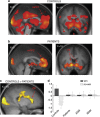Abnormal brain activity during a reward and loss task in opiate-dependent patients receiving methadone maintenance therapy
- PMID: 24132052
- PMCID: PMC3924523
- DOI: 10.1038/npp.2013.289
Abnormal brain activity during a reward and loss task in opiate-dependent patients receiving methadone maintenance therapy
Abstract
A core feature of human drug dependency is persistence in seeking and using drugs at the expense of other life goals. It has been hypothesized that addiction is associated with overvaluation of drug-related rewards and undervaluation of natural, nondrug-related rewards. Humans additionally tend to persist in using drugs despite adverse consequences. This suggests that the processing of both rewarding and aversive information may be abnormal in addictions. We used fMRI to examine neural responses to reward and loss events in opiate-dependent patients receiving methadone maintenance treatment (MMT, n=30) and healthy controls (n=23) using nondrug-related stimuli. Half of the patients were scanned after/before daily methadone intake (ADM/BDM patient groups). During reward trials, patients as a whole exhibited decreased neural discrimination between rewarding and nonrewarding outcomes in the dorsal caudate. Patients also showed reduced neural discrimination in the ventral striatum with regard to aversive and nonaversive outcomes and failed to encode successful loss avoidance as a reward signal in the ventral striatum. Patients also showed decreased insula activation during the anticipation/decision phase of loss events. ADM patients exhibited increased loss signals in the midbrain/parahippocampal gyrus, possibly related to a disinhibition of dopamine neurons. This study suggests that patients with opiate dependency on MMT exhibit abnormal brain activations to nondrug-related rewarding and loss events. Our findings add support to proposals that treatments for opiate addiction should aim to increase the reward value of nondrug-related rewarding events and highlight the importance of potential abnormalities in aversive information processing.
Figures





References
-
- Berridge KC. The debate over dopamine's role in reward: the case for incentive salience. Psychopharmacology. 2007;191:391–431. - PubMed
-
- Buhler M, Vollstadt-Klein S, Kobiella A, Budde H, Reed LJ, Braus DF, et al. Nicotine dependence is characterized by disordered reward processing in a network driving motivation. Biol Psychiatry. 2010;67:745–752. - PubMed
-
- Curran HV, Kleckham J, Bearn J, Strang J, Wanigaratne S. Effects of methadone on cognition, mood and craving in detoxifying opiate addicts: a dose-response study. Psychopharmacology. 2001;154:153–160. - PubMed
Publication types
MeSH terms
Substances
LinkOut - more resources
Full Text Sources
Other Literature Sources
Medical

